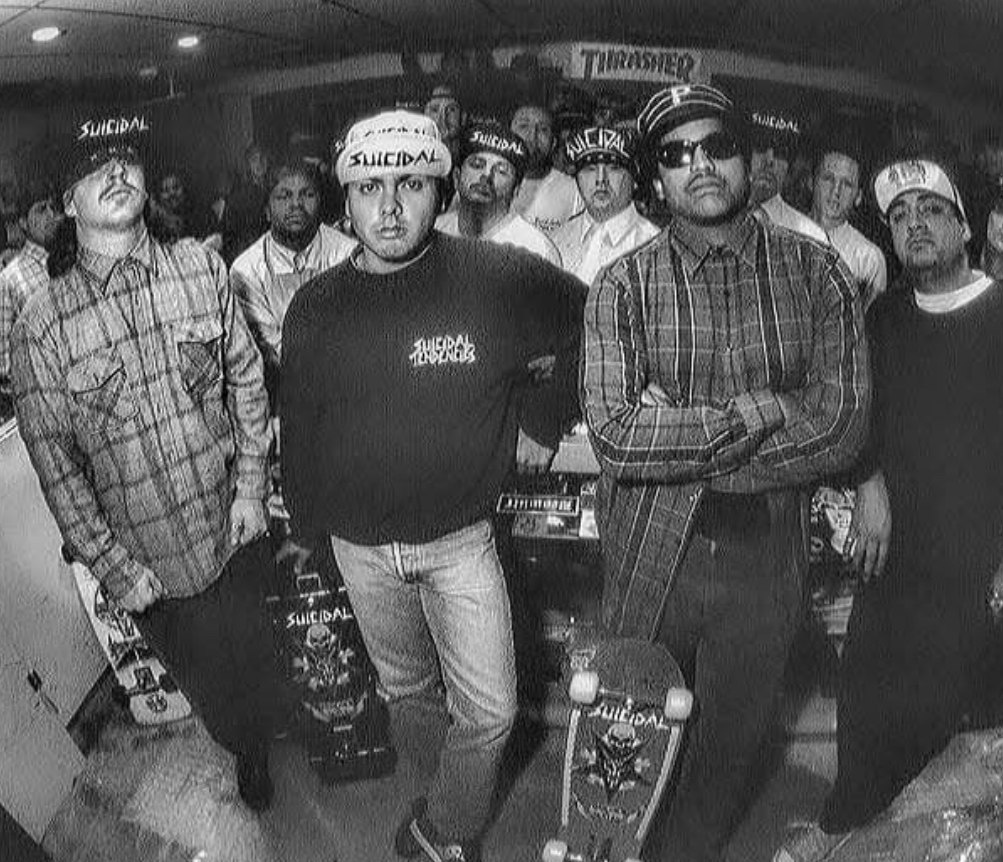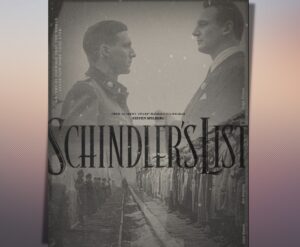By 1987, Suicidal Tendencies had solidified their reputation as one of the most influential bands in the hardcore punk and crossover thrash scenes. With their deep roots in Venice, California, the band embodied the raw energy of skateboarding culture, gang aesthetics, and aggressive music that resonated with disenfranchised youth. One of the most iconic photos from this era, taken by Chuck Katz, captures the essence of Suicidal Tendencies at Streets of Venice Records & Skateshop, a legendary spot that played a key role in the local punk and skateboarding movement.
This was a time when punk rock, skateboarding, and street culture were deeply intertwined, creating a rebellious aesthetic that influenced generations to come. The imagery of the band—bandanas, flannel shirts, and custom skate decks—became a visual representation of their sound and ethos.
Venice, California: The Breeding Ground of Suicidal Tendencies
Venice, also known as “Dogtown,” had long been a hotbed for counterculture movements. The area was home to the Z-Boys, who revolutionized skateboarding in the 1970s, and by the early ‘80s, it had also become a breeding ground for hardcore punk. The beach town, with its graffiti-covered walls, rough neighborhoods, and DIY ethos, provided the perfect backdrop for a band like Suicidal Tendencies.
Founded by frontman Mike Muir in 1980, Suicidal Tendencies quickly gained notoriety for their high-energy performances, confrontational lyrics, and unique style that blended hardcore punk with elements of metal. Though their 1983 self-titled debut album spawned the infamous track Institutionalized, which became a cult classic, the band was constantly battling censorship, venue bans, and a reputation for inciting violence at shows. Despite these obstacles, Suicidal Tendencies built a dedicated following that extended far beyond punk circles, attracting skaters, street kids, and even gang affiliates who identified with their aggressive attitude and anti-establishment themes.
Streets of Venice Records & Skateshop: A Cultural Hub
Streets of Venice Records & Skateshop was more than just a retail space—it was a gathering point for punks, skaters, and musicians who were shaping the underground culture of Southern California. Located in Venice Beach, the shop carried a mix of punk records, skate gear, and graffiti supplies, making it a one-stop destination for rebellious youth looking for an alternative to mainstream fashion and music.
The shop became an unofficial clubhouse for the Venice Suicidals, a loosely affiliated group of fans and skaters who were dedicated to Suicidal Tendencies. They adopted the band’s signature style—bandanas tied low over the forehead, baggy pants, and flannel shirts buttoned at the top—which later influenced the early cholo-punk crossover aesthetic. The “Suicidal Skates” brand, which emerged around this time, was a connection between Suicidal Tendencies and skateboarding pioneers, further cementing the band’s presence in the skate scene.
Chuck Katz & The 1987 Photo
Chuck Katz, a photographer known for capturing the raw energy of punk and skateboarding culture, took one of the most well-known photos of Suicidal Tendencies at Streets of Venice in 1987. This image is iconic because it captures not only the band’s aesthetic but also the essence of a pivotal moment in hardcore and crossover thrash history.
The photo features the band in their signature look, standing outside the shop, exuding an effortless cool that would later inspire streetwear brands, graffiti artists, and musicians alike. It also highlights the close-knit relationship between the music and skateboarding worlds—something that had been evident since the early days of hardcore punk but was reaching new heights with bands like Suicidal Tendencies, Black Flag, and the emerging thrash metal scene.
Musical Evolution: Join the Army and the Shift Toward Crossover Thrash
In 1987, Suicidal Tendencies released their second album, Join the Army, marking a shift from their purely hardcore roots toward a more metallic sound that would later be recognized as crossover thrash. This subgenre fused the speed and aggression of punk with the heaviness of thrash metal, appealing to both mosh pits and skate parks alike.
Join the Army featured tracks like Possessed to Skate, an anthem for skateboarders that reinforced the band’s deep connection to the sport. The music video for Possessed to Skate showcased aggressive skating, DIY ramps, and the chaotic energy of a backyard skate session—cementing the band’s influence in the skateboarding world. The song became a rallying cry for skaters, and its lyrics embodied the defiant spirit of the scene:
”’Cause I’m possessed to skate!
Possessed to skate!”
At a time when mainstream culture was still trying to marginalize punk and skateboarding, Suicidal Tendencies was proving that these subcultures were thriving on their own terms.
The Impression of Suicidal Tendencies on Skate and Street Culture
Suicidal Tendencies wasn’t just a band—they were a movement. Their influence extended far beyond music, shaping fashion, attitude, and even skateboarding tricks. Many of the top skaters of the late ‘80s and early ‘90s—such as Christian Hosoi, Steve Caballero, and Tony Hawk—were known to blast Suicidal Tendencies while skating. The band’s aggressive sound became the perfect soundtrack for pushing limits, whether it was on a skateboard or in a mosh pit.
Additionally, Suicidal Tendencies’ association with Dogtown culture helped bridge the gap between punk and gang aesthetics. The band’s look was often misinterpreted by outsiders as gang-related, but in reality, it was a reflection of Venice’s street style. The Suicidal logo, with its distinct Old English font, became a staple in underground fashion, influencing streetwear brands decades later.
Their merchandise—bandanas, snapbacks, and oversized shirts—became sought-after items, and the Suicidal Skates brand allowed them to extend their influence into the skateboarding industry. This made Suicidal Tendencies one of the first punk bands to successfully merge music and lifestyle branding, paving the way for later bands and skate companies to do the same.
Legacy of 1987 and Beyond
The Join the Army era, captured so vividly in Chuck Katz’s 1987 photograph, marked a turning point for Suicidal Tendencies. It was the moment when they evolved from a local Venice Beach hardcore band to a global force in punk and metal. Their transition into crossover thrash set the stage for future albums like How Will I Laugh Tomorrow When I Can’t Even Smile Today (1988) and Lights… Camera… Revolution! (1990), which would further solidify their influence.
More importantly, their presence in the skate scene helped legitimize punk music as a vital part of skateboarding culture. Even today, Suicidal Tendencies remains one of the most respected names in both the punk and skate worlds, with their imagery, music, and ethos continuing to inspire new generations of skaters, musicians, and street artists.
Final Thoughts
The 1987 photo of Suicidal Tendencies at Streets of Venice Records & Skateshop, taken by Chuck Katz, captures more than just a band—it captures a movement. It’s a snapshot of a time when punk, metal, and skateboarding were colliding in ways that would shape underground culture for decades to come.
Suicidal Tendencies wasn’t just about music; they were about a way of life—one that embraced rebellion, individuality, and the unbreakable connection between punk rock and skateboarding. The legacy of that era still echoes today, whether in the fashion choices of modern skaters, the soundtracks of skate videos, or the continuing success of Suicidal Tendencies as a band that never compromised its identity.
In the end, 1987 wasn’t just another year for Suicidal Tendencies—it was the year they truly became a movement.
No comments yet.








